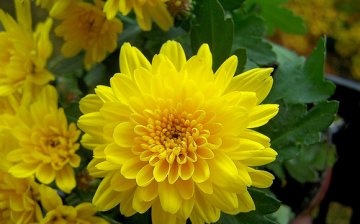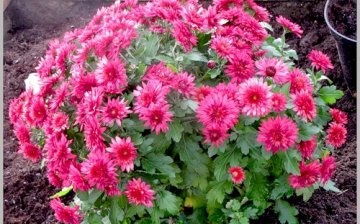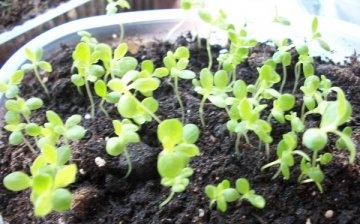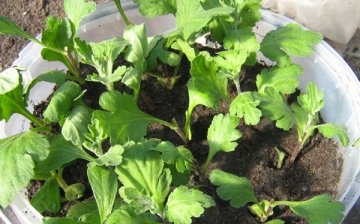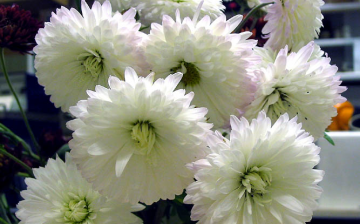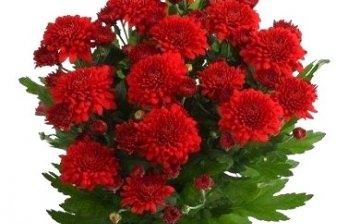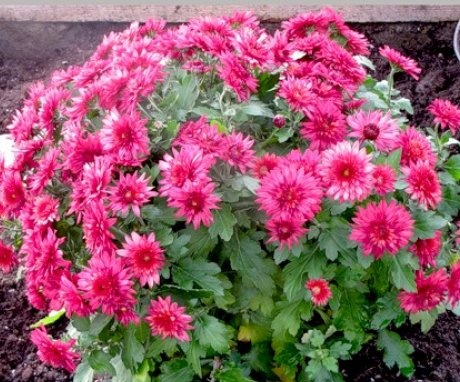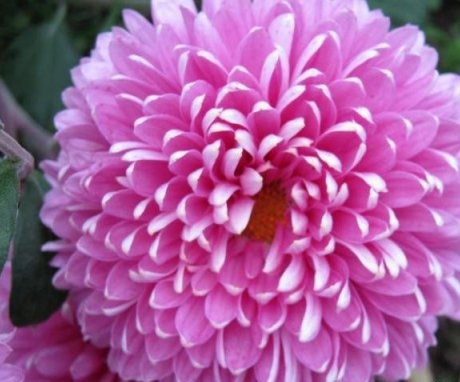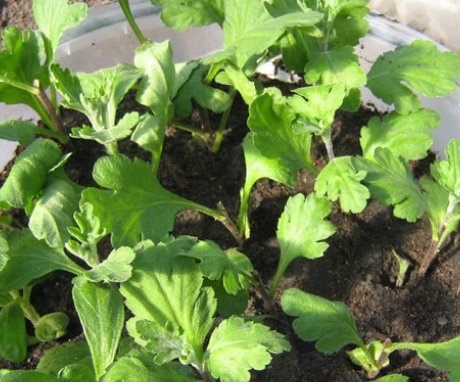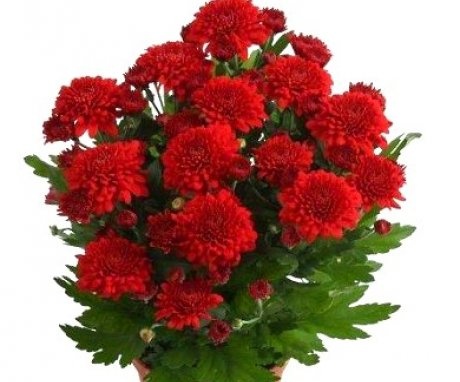Indian chrysanthemum: characteristics, cultivation and agricultural technology
More than two and a half thousand years ago, the triumphal procession of chrysanthemums began around the world. Then one Chinese philosopher said: "If you want to be happy, grow chrysanthemums."
Content:
- Description of Indian chrysanthemum
- Cultivation of Indian chrysanthemum
- Growing from seeds
- Indian chrysanthemum cuttings
- Useful properties of Indian chrysanthemum
- Popular types
Description of Indian chrysanthemum
Indian chrysanthemum is a perennial... The stem height can reach 1.5 meters, but the average value is 80-100 centimeters. In winter, it dies off. Belongs to the Asteraceae or Compositae family.
Translated from the Greek language, chrysanthemum is a golden flower.
Features of the plant:
- The name is based on the characteristic of the color of the inflorescence - golden yellow in all types of chrysanthemums.
- It has rather simple stems, dissected leaves (serrate-toothed).
- The inflorescence is a basket. The seeds ripen by December. Flowering peaks in September-November. However, flowering is possible from August to December.
- The dislocation of the plant is the entire territory of the Middle East, Europe, India, the Caucasus. But on the open ground, Indian chrysanthemums grow only in the southern regions.
- Otherwise, these beautiful flowers are grown using agricultural technology in a sheltered location or as indoor plants.
Cultivation of Indian chrysanthemum
With the duration of flowering chrysanthemums can argue only orchids... But chrysanthemums bloom at a time when the brightness of the colors is dulled - in the fall. This quality of chrysanthemums attracts attention. Large chrysanthemums were originally called "Indian", since at that time all plants from the East were called so.
Now more than 10 thousand varieties of Indian chrysanthemums have been bred. They have a variety of shapes, colors, sizes.
Flower enthusiasts, fascinated by this wonderful plant, cultivate Indian chrysanthemums using spring cuttings method from the mother bushes. They are stored at low temperatures without hypothermia in specially designated places: basements, insulated greenhouses, greenhouses.
However, it is very difficult for an amateur to grow chic Indian chrysanthemums with large flowers on their own in the garden. But, if you apply the advice of experienced florists, having prepared everything you need for this, then the opportunity to make your dream come true. There are 2 methods for sprouting chrysanthemums.
Growing from seeds
When growing flowers from seeds, you must adhere to some rules:
- Chrysanthemum Indian in open ground is planted only in the form of seedlings.
- The seeds are first wrapped in a damp cloth and foil.
- Store in a refrigerator at a temperature of +5 degrees for several days.
- Into the soil planting wet seeds, in rows.
- The soil in the box should always be moist.
- Seeds are slapped into the ground, but not covered, thus providing access to lighting.
- Cover trays or boxes with planted seeds with foil, periodically airing.
- After seed germination, the film is removed, the soil is loosened.
- In the open air, seedlings are planted after the onset of warm days.
- The distance between the bushes should be at least 50 centimeters.
- The soil is necessary periodically loosen and moisturize.
- Flowers must have full access to light.
- After the end of flowering, the stems are cut at a height of 10-20 centimeters, placed in boxes with moistened sand.
- Store the winter at a temperature of +2 - +5 degrees without irrigation.
Indian chrysanthemum cuttings
When grown by cuttings of Indian chrysanthemum, there are rules:
- Cuttings up to 20 centimeters long are introduced into the soil for rooting in the spring.
- For the germination of shoots, they are covered with a film on arcs.
- Ventilate periodically.
- The film should not come into contact with the planted cuttings.
- After sprouting chrysanthemums, the film is removed.
- Cuttings and leaves sprouted on them should not touch.
- It is advisable to feed the shoots with nitrogen fertilizers.
There is also a way of sprouting Indian chrysanthemums by cuttings.
The difference is that before planting flowers in the ground, they are germinated in pots. until complete rooting... And after disembarkation, they are not covered with polyethylene.
In general, the Indian chrysanthemum is a hardy plant. These varieties are drought-resistant and cold-resistant. But the plant does not tolerate darkness, it is photophilous. Prefers fertile land. In the middle lane in the open space, the Indian chrysanthemum develops slowly, does not bloom for long, has medium-sized inflorescences. The best time to plant a flower bed is May. The plant is afraid of some pests.
Among the most dangerous for chrysanthemums are aphids, chrysanthemum nematodes and red spider mites.
With poor care and strong watering, the flower can infect powdery mildew... In such cases, isolation of the diseased plant and treatment with an insecticide are required.
Different varieties of Indian chrysanthemums can be grown on the same flower bed, which will make the composition bright and distinctive. The main thing in the composition is the correct selection of chrysanthemums.
Useful properties of Indian chrysanthemum
The culture of growing these beautiful flowers has a centuries-old tradition. These flowers, including many species of Indian chrysanthemums, have been bred since 550 BC. In Europe, chrysanthemums gained their authority in the 17th century.
These flowers have long been an object of admiration. They are depicted on coins and state symbols. Chrysanthemums are mentioned in poems and songs. Many varieties of this plant used as a medicinal raw materialsome are edible.
Flower petals are used as a medicinal raw material during the period of their intense flowering.
They contain:
- Essential oil.
- Camphor.
- Glycoside.
- Choline.
- Vitamin A.
- Adenine.
Eufualacon was found in the composition, which is the nucleus of chamazulene. Chrysanthemum flowers are brewed as a tea to whet the appetite. And the essential oil of the plant has a beneficial effect on the subcortical regions of the human brain in the fight against Parkinson's disease. The infusion of chrysanthemum petals, cooked in a water bath, perfectly relieves fever and soothes fever.
Poultices based on fresh chrysanthemum leaves are an excellent remedy for migraine headaches.
Popular types
The most popular among florists are the following varieties of Indian chrysanthemums:
- Aurora. It has flat orange inflorescences. The flowers are flat, with a diameter of up to 10 centimeters. Blooms from September to October. It can grow up to 1 meter in height.
- Altgold. It has a dense double inflorescence of golden yellow color and flat shape. Flowering period: August to October. The stem is low.
- Primavera. The flower is pale pink, hemisphere, up to 10 centimeters in diameter. The plant is tall. Blooms from September to October.
- Snow elf. Chrysanthemum pompon, white, terry. Flowers with a diameter of 5 to 8 centimeters. The plant is of medium height. Blooms in autumn.
- Anastasia.Flower color: white, yellow, pink, lilac, green or lemon. The diameter of the inflorescence is huge - up to 17 centimeters. Flat inflorescence, fragile and refined. Blooms all autumn.
- Artist. Flat inflorescence with two-colored petals: stripes of white and pink. A small shrub with a long flowering period.
- Vimini. This is a small "sunflower". Petals of yellow, orange and lemon color with a brown core. Has a short flowering period.
- Tziya. Medium-sized flowers with maroon petals with a white border and a green core. The bushes are low.
- North Bye. Long blooming variety. Medium-sized inflorescences with a yellow-green heart and bicolor petals. The petals are yellow-white with a purple stripe.
- Like Worth. These are chamomile chrysanthemums. Large flat orange inflorescences with a yellow stripe are gathered around a green center. They combine singularity and simplicity.
- Carnival. This variety is distinguished by a variety of colors and double flowers. Blooms for a very long time.
List all varieties Indian chrysanthemum can be long. They are all magnificent in their bloom. Most of these flowers are the result of selection work. These are thousands of hybrids. Having fallen in love with these beautiful flowers once, it is no longer possible to stop loving them.
They embody style and beauty, sophistication and originality, sophistication and extravagance.
More information can be found in the video.



